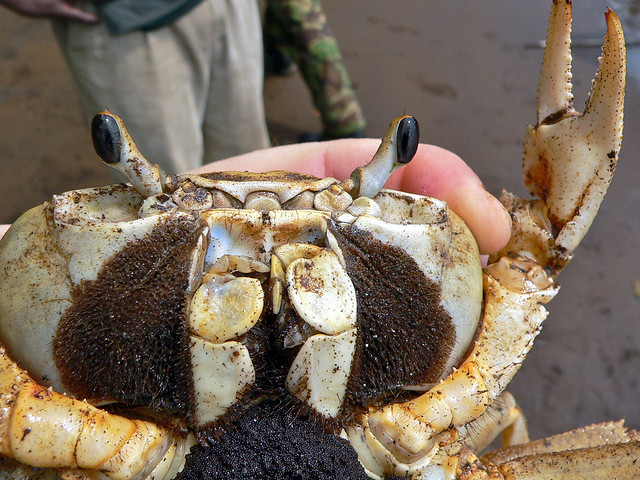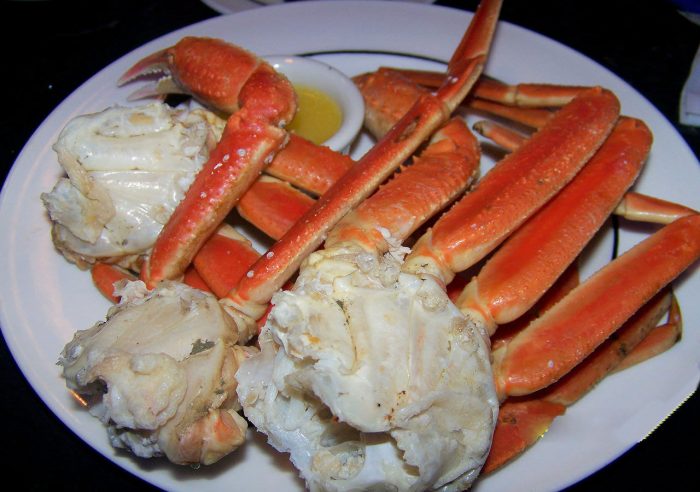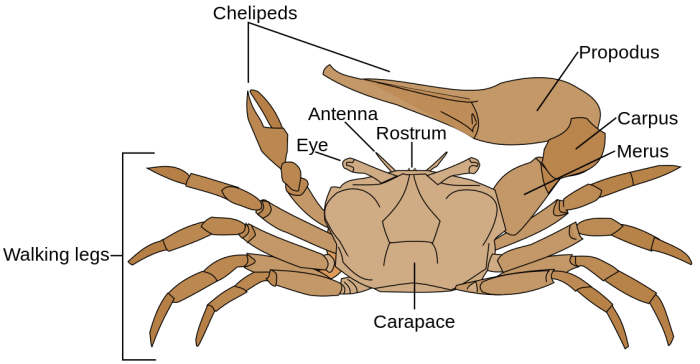
They are creepy, they are crawly, they are….crabby? Crabs are a type of crustacean and fall under the taxonomical order Brachyura. Crabs under the order Brachyura area considered “true” crabs. Many animals that share the name crab—such as hermit crabs, horseshoe crabs, and crab lice—do not fall under this order and so are not considered “true” crabs. Crabs spend most of their time on the ocean floor or in the shallows scrounging for algae, worms, plankton, and small aquatic animals.
Crabs are one of the most common animals. There are currently over 6,700 known distinct species of crab that are divided between 93 groups. Most of these species live in the oceans, though many live in freshwater bodies like river and streams and some spend much of their life on land. The earliest identified crab fossils date back to the Jurassic period; approximately 135 million years ago, though most extant species of crab emerged in the late Cretaceous and Tertiary periods. Despite common misconceptions, crabs are not mollusks. They are arthropods and actually fall under the same grouping as spiders, scorpions, and insects.
Crab Anatomy
The most distinguishing feature of crabs is their hard exoskeleton. Crab exoskeletons are made out of chitin, the same carbohydrate that makes up the exoskeleton of insects and that is found in the cells of fungi. Crab exoskeletons incorporate many minerals, most notably calcium carbonate, a mineral that is commonly found in the shells of aquatic animals. The chitinous exoskeleton that covers the top of the carb is called the carapace which functions to protect the crab from damage and regulate its internal temperature. Crabs can vary in size from a few millimeters (pea crab) to a leg span of over 4 meters (Japanese spider crab).
Over its lifespan, a crab will periodically shed its outer carapace in a process called molting. Because the carapace does not grow in tandem with the rest of the body, crabs must shed their outer shell every so often to develop properly. This is a difficult and time-consuming process that can be fatal if the crab becomes stuck and cannot exit its old shell.
Crabs are also identified by the large front pincer claws (chelipeds). Each claw is divided into three parts: the outer margin, carpus, and claw. The grasping part of the terminal end of the claw has two parts: a moving finger and a fixed finger. Many species of crab have one claw that is larger than the other and can be used for smashing and striking or as a mating display. Interestingly, crab claw asymmetry seems to prefer right-handedness. Most of the time, crabs have 10 legs, including their claws.
Most species of crab display sexual dimorphism. Variations among sexes may manifest as different carapace size, color, shape, claw size, and mating behavior. For example, male fiddler crabs usually have one claw much larger than the other while females have two small claws. Male fiddler crabs use their large claw to compete for female attention. Male and female crabs also tend to have different carapace shapes. Males display a small narrow triangle while the female abdomen is rounded and smooth. This difference in anatomy relates to the female’s tendency to store her eggs on the underside of the carapace.
Crab Diet/Behavior

A beach crab eating some lichen. Credit: A Emad via WikiCommons CC-BY SA 4.0
Crabs are omnivores and subsist on a diet of mainly algae, worms, fungi, bacteria, dead organic material, and smaller mollusks, crustaceans, and fish. Some crabs are scavengers and sweep the ocean floor looking for food while others actively stalk and hunt prey. Crabs are known for their unique sideways gait that is a result of the ways their legs are oriented. Some crabs do walk forward and backward while others can actually swim. For instance, crabs in the Portunidae order have back legs that are flattened into paddles that help them swim.
Most crabs make their habitat in crevices on the ocean floors and caves near rocky seashores. Many species of crab move to the shallows during high tide to search for food which is one reason they can commonly be found in tide pools.
Crabs are territorial and aggressive. Very often, males fight between themselves for female attention and for living spaces. Despite this characteristic aggression towards conspecifics of the same sex, some species of crab form families that live together and work to provide each other with food and protect their young. Other species are more solitary and live alone. Crabs display some rudimentary forms of communication such as waving and creating snapping sounds with their claws.
Despite their relatively small and primitive brains, there is evidence that many species of crabs are capable of forming long term memories and modifying future behavior based on those memories. Long-term memory formation is commonly assumed to require a complex brain with multiple functional parts, yet crabs manage this task with a relatively small collection of neurons.
The discovery of complex memory formation in crabs has important bearings on other questions about crab cognition. For example, it is still a hotly debated question whether crabs and other crustaceans are capable of feeling pain. Many believe that crabs lack brain structures necessary for conscious experience and thus cannot feel pain, while others point to the presence of opioid receptors structurally similar to mammals in crabs as evidence that they can feel pain just as vertebrates do. The question of the complexity of crustacean cognition has many ethical implications in regards to how crustaceans are used in research, how they are prepared as food, and how they are raised and cultivated.
Crab Lifecycle/Reproduction
Crab lifespan differs greatly depending on the species. Some crabs like the Japanese crab spider are thought to live for over 100 years while others like Blue crabs only live 2-3 years. Most species of crab pass through several developmental stages over the course of their life, somewhat analogous to the developmental stages that insects go through. The exact number of immature stages depends on the species and each stage is separated by a molting. Once it reaches the megalopa stage, the immature crab takes on a morphology that begins to resemble that of an adult crab. The transition from the megalopa stage to the juvenile stage is the most crucial point in crab development and must take place in a highly specific environment.
Once the immature crab reaches maturity, it set’s out in search of a mate. Crabs attract mates through a combination of pheromones, acoustic signals, visual cues, and displays of aggression. Generally, males compete fiercely for female attention and will fight each other using their oversized single claw. Once a mate has been selected, the male crab will insert its gonopods (sexual organs) into the female’s gonophores and deposit its sperm in a sac called the spermatheca.

A female crabs with her eggs on the underside of the carapace. Credit: B. Dupont via Flickr CC-BY SA 2.0
Females will carry the sperm around for some time before fertilizing their eggs, after which they store them on the underside of their bodies while the embryos develop. Once the eggs reach a larval stage, they are released into the water. Many species of land crab will make an extensive migration to the oceans to release their larvae, after which the larvae make the reverse migration back to land. This migration is the single biggest cause of death among crab populations as during the migration they are exposed to numerous predators and environmental hazards. Specifically, the construction of roads near crab-populated shores is correlated with increased crab deaths during the migratory period.
Crabs & Humans
Crabs have long been a source of food for humans, particularly in coastal communities that are near shorelines and oceans. Over 1.5 million tons of crab are fished each year, with the Japanese blue crab making up about one-fifth of that total amount. Other commonly consumed species of crab include the snow crab, Dungeness crab, and some mud crabs.

A plate of snow crab legs. Credit: Public Domain
Crabs are eaten in a variety of ways. Some species are eaten whole, shell included, and for some species just the legs and claws are eaten. Crab eggs are also a common dish in cultures in Southeast Asia and the Mediterranean. Crab is also a major ingredient of many types of Japanese and Korean sushi.
While the majority of species of crab are neither endangered nor threatened, there is a growing worry about the potential effects of overfishing and climate change on crab populations. Overfishing in the past 30 years have led to the endangerment of many traditional sources of seafood and crabs could be the next species to become endangered. The changing of the oceans mineral content from climate change could also cause a decline in crab populations by altering the mineral content of their shells. Specifically, the disruption of the carbon cycle by human fossil fuel emissions runs the risk of changing the concentration of carbonate deposits in the ocean.










